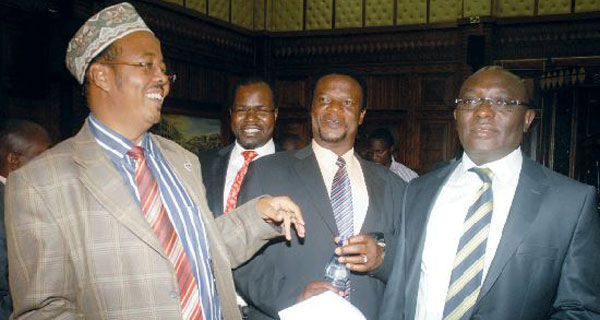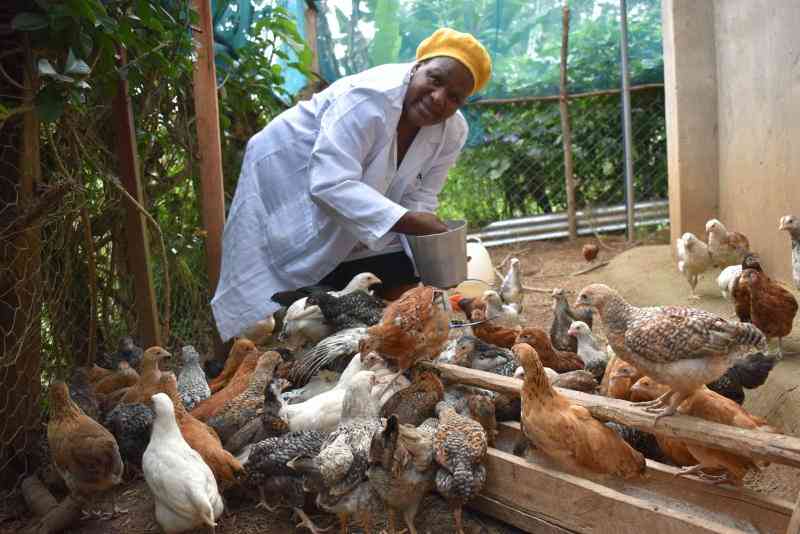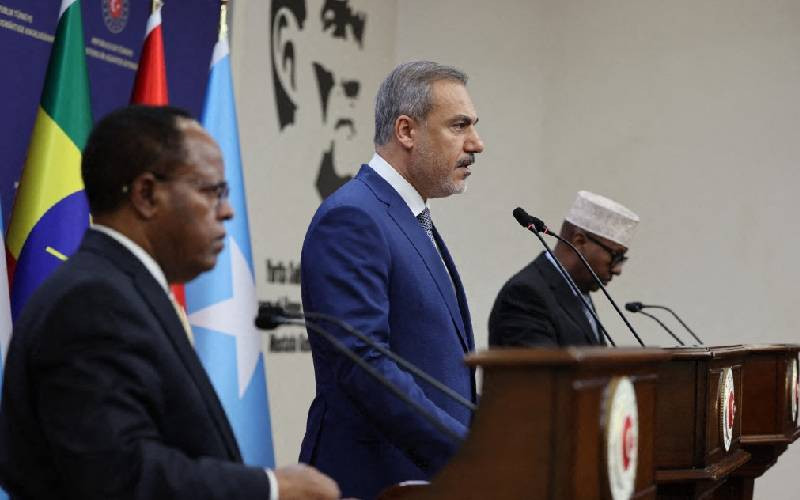 |
|
Parliamentary Public Investment Committee chairman Adan Keynan (left) with other members of the committee after addressing a press conference on the Standard Gauge Railway project in Nairobi, Wednesday. [PHOTO: BONIFACE OKENDO/STANDARD] |
By PAUL WAFULA and TIMOTHY MACHI
Kenya Railways questioned the feasibility study on the multi-billion Standard Gauge Railway, dismissing it as not returning “a bankable project”.
In a letter to the then Transport PS Cyrus Njiru dated April 4, 2011, Transport Principal Secretary Nduva Muli, while serving as the managing director of Kenya Railways, ripped apart the study, saying the project was “of lower standard compared to Kenya Railway’s specifications.”
Yesterday, Government officials, however, moved to allay fears on viability of the project and said Mr Muli’s reservations were comprehensively addressed in the final report.
In his 2011 letter, Muli questioned the study, saying it relied on secondary data, some of which was outdated. “The study report falls short of delivering a bankable project, which should portray the project as a railway business capable of attracting investors for profit taking,” Muli said.
“A railway (unlike a road) must be designed, built and operated as a business...to avoid the expensive investment turning into a white elephant,” he wrote in the same letter that also concluded the cost estimates “by any standards were very high.”
Muli used bold letters to stress the words ‘bankable project’ and was responding to Mr Njiru on why the project was not viable.
The revelations come a day after President Uhuru Kenyatta invited the public to submit any crucial evidence against the project to Parliament or send it directly to him even as he said the project would continue as planned.
The correspondence between Muli and Njiru in 2011 happened just a month after President Kibaki’s government rejected the project since there was no one in government who was in support of the study, according to Njiru.
“The Minister has indicated on the brief that... since there is no one in the government who is in support of the study, there is therefore no need to proceed with it,” Njiru wrote in a letter to Muli dated March 16, 2011.
“I have therefore been directed to advise you not to go ahead with the study as this is not consistent with the consensus within government,” Njiru wrote.
Muli’s 11-page letter reveals that Kenya Railways employees were never involved in the actual study. “KR did not participate in developing the Terms of Reference for the study nor was it involved during the study,” Muli said. “A study of this magnitude would require KR staff participating as counterpart personnel,” he said in the letter also copied to Investment Secretary Esther Koimet.
China Roads and Bridges Corporation (CRBC) did the study for ‘free’ and was later handed the project to implement.
In conclusion, Muli described the technical and operational design parametres of the project as “of lower standard than Kenya Railway’s expectations.”
In addition, Muli notes that at least nine vital reports, including the technical study, the market study, the environmental impact assessment, and the financial modeling report that determined the profitability of the railway project were not provided at that time to allow Kenya Railways analyse the findings and conclusions.
Stay informed. Subscribe to our newsletter
While a source at Transcom House indicates that most of Muli’s earlier reservations were addressed as part of the reviewing process, the design of the railway has remained as earlier presented in the initial feasibility study. Muli, now the Transport PS, is responsible for its implementation.
Number of bridges
In his 2011 letter, Muli said the minimum KR expected was a double line track. It is, however, the single line presented in the first feasibility study that was adopted in the final design of the railway.
His recommendation to reduce the number of bridges, tunnels and crossings, which he said accounted for 7.2 per cent of total length of the line, and possible reason for the high cost, also appear not to have been adopted.
Kenya Railways Project Manager Eng Solomon Ouna, however, yesterday defended the retention of the number of bridges as necessary to keep the gradient of the track at 1.2 per cent.
Muli’s recommendation of a “hybrid design” of railway – that it first starts running on diesel and later convert to electric – are in the final project document, suggesting that some of his suggestions were adopted. But even this has limitations and hinges on availability of sufficient electricity.
The railway is designed to use up to 1,200 mw of power per year. Currently, however, Kenya only produces about 1,700 mw. This means that until there is sufficient power supply, the trains will run only on diesel, thereby substantially reducing their speed.
Muli’s letter also revealed that the capacity of the SGR would be exhausted in just 13 years after it is commissioned against the Kenya Railways expectation of between 50 to 100 years.
“Assuming the project will be commissioned by 2017, this means the proposed line will be approaching its full capacity within 13 years of commissioning!” an alarmed Muli wrote.
However, the government yesterday said this has since been reviewed and that the Standard Gauge Railway reaches its full capacity in 60 years.
KR’s initial expectation was that the new railway should meet the long-term traffic demand (50 – 100 years) in the region without the need to incur expensive modifications to the infrastructure in future.
The letter also noted that “there are several gaps in the consultant’s analysis of transport demand and forecasts.”
“Transport demand forecasts and how the rail market share was arrived at are not clear. Neither has the consultant determined elasticity of transport demand or cross-elasticity between the different transport modes,” the letter read in part.
What is likely to rock the project further was Muli’s admission that it would be just as expensive to use the new railway line as the pipeline or road network if the current barriers to the latter are eliminated.
“A major fraction (44 per cent) of the road costs are attributable to indirect costs of delays that are not attributable to the road transporters but to the regulatory framework, and if these barriers are reduced or removed altogether, the road will pose serious competition to the rail,” he said.
Also, the SGR study had concluded that passenger traffic would not be profitable. But a source who spoke to The Standard said a financial remodeling was done to allow cargo train business to subsidise the passenger train — allowing for a reduction of the projected passenger fares from Nairobi to Mombasa from the Sh4,500 quoted earlier to Sh800.
Muli’s letter also argues that the proposed tariff for ferrying oil by rail would be $0.04 per tonne per kilometre, against an oil pipeline tariff of $0.043 per tonne per kilometer, which would not make the railway line more attractive for fuel shipments than the pipeline.
“This (tariff) suggests that rail would attract less white oil traffic currently under pipeline monopoly as pipeline fares remain competitive. This complicates the ability of rail to increase its market share, and also create competition or complementarity in the white oil transport,” the letter says.
[email protected]
[email protected]
 The Standard Group Plc is a
multi-media organization with investments in media platforms spanning newspaper
print operations, television, radio broadcasting, digital and online services. The
Standard Group is recognized as a leading multi-media house in Kenya with a key
influence in matters of national and international interest.
The Standard Group Plc is a
multi-media organization with investments in media platforms spanning newspaper
print operations, television, radio broadcasting, digital and online services. The
Standard Group is recognized as a leading multi-media house in Kenya with a key
influence in matters of national and international interest.
 The Standard Group Plc is a
multi-media organization with investments in media platforms spanning newspaper
print operations, television, radio broadcasting, digital and online services. The
Standard Group is recognized as a leading multi-media house in Kenya with a key
influence in matters of national and international interest.
The Standard Group Plc is a
multi-media organization with investments in media platforms spanning newspaper
print operations, television, radio broadcasting, digital and online services. The
Standard Group is recognized as a leading multi-media house in Kenya with a key
influence in matters of national and international interest.










